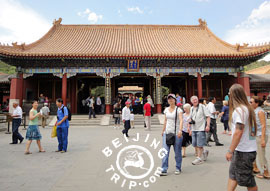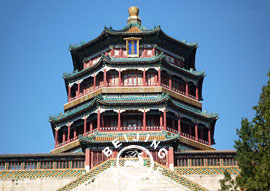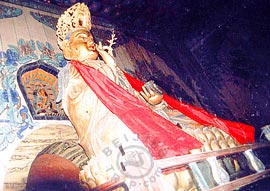 Hall of Dispelling Clouds
Hall of Dispelling Clouds

The Hall of Dispelling Clouds (Paiyundian) is a splendid structure with red columns and a roof covered with golden yellow tiles. It is built on a platform which is framed by white marble balusters and adorned with bronze dragons, phoenixes and vessels. Inside the hall sits a throne, flanked by a screen, incense burners and fans. The screen is ancient and elegant with exquisite enamelwork embedded in a red backing. Also on display are some precious gifts presented by ministers to Empress Dowager Cixi on her seventieth birthday. The hall together with the adjoining wing halls has 21 rooms, all of which are connected by cloisters.
Such a hall of great luxury was used only once a year for a ceremony to celebrate Cixi's birthday. During the ceremony, Cixi sat on the throne inside the hall while Emperor Guangxu and the other ministers came to show their respect and honor to her. The hall is located in the middle of the front hill and the Tower of Buddhist Incense, a symbol of theocracy, lies at its back. The tower embodies the divine right of the king.
 Tower of Buddhist Incense
Tower of Buddhist Incense

The Tower of Buddhist Incense (Foxiangge) is the symbol of the Summer Palace and an elaborate work of classical architecture. The three-storied tower, situated on a hill, is about 40 meters (131 feet) high and has a complicated structure. It has eight facades and quadruple-layered eaves, and the whole is supported by eight pillars of lignum vitae wood. It is the center of Summer Palace, with buildings distributed symmetrically around its base. The Precious Cloud Pavilion (Baoyunge) to the west of the tower, made out of 207 tons (456,357 pounds) of bronze, is exquisite and noteworthy.
 Hall of the Sea of Wisdom
Hall of the Sea of Wisdom
At the top of the Longevity Hill is the Hall of the Sea of Wisdom (Zhihuihai), whose name recalls the infinite wisdom of the Buddha. No wooden pillars or girders have been used in the construction of this two-storied hall; instead, masonry arches provide structural support. Inside the hall is worshiped Kwan-yin and its outer wall takes on an uncommon scene. The whole wall was beautifully decorated with colored glazed flakes and there are over one thousand small Buddha statues in the wall.
 In front of the hall there is a Paifang, an ancient Chinese gateway, named Zhongxiangjie. The Hall of the Sea of Buddhist Incense symbolizes the Buddhist land while the gateway serves as the door leading to pure land. To get here, one must plod by steps which were built on purpose to test the pilgrims' religiosity. It is also made up of bricks and stones and is inlayed with color glaze on its exterior. Due to its structure, the gateway, together with the Hall of the Sea of Wisdom, is the scarce survivor that escaped from the fire set by the Anglo-French Allied Forces.
In front of the hall there is a Paifang, an ancient Chinese gateway, named Zhongxiangjie. The Hall of the Sea of Buddhist Incense symbolizes the Buddhist land while the gateway serves as the door leading to pure land. To get here, one must plod by steps which were built on purpose to test the pilgrims' religiosity. It is also made up of bricks and stones and is inlayed with color glaze on its exterior. Due to its structure, the gateway, together with the Hall of the Sea of Wisdom, is the scarce survivor that escaped from the fire set by the Anglo-French Allied Forces.
 Go to the Next Attractions: Back Lake, Suzhou Market Street & Garden of Harmonious Interests
Go to the Next Attractions: Back Lake, Suzhou Market Street & Garden of Harmonious Interests